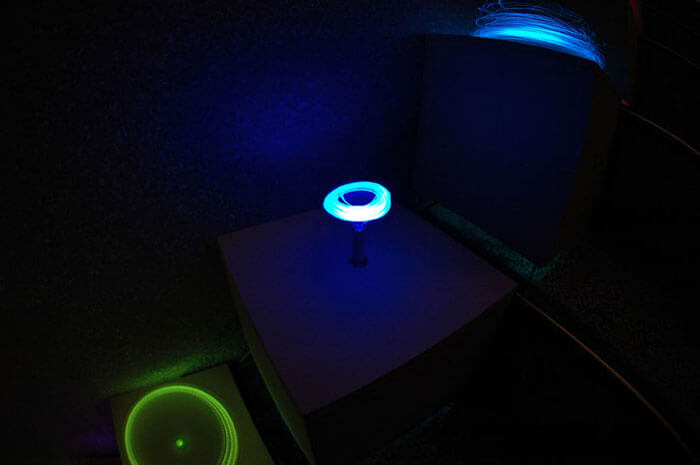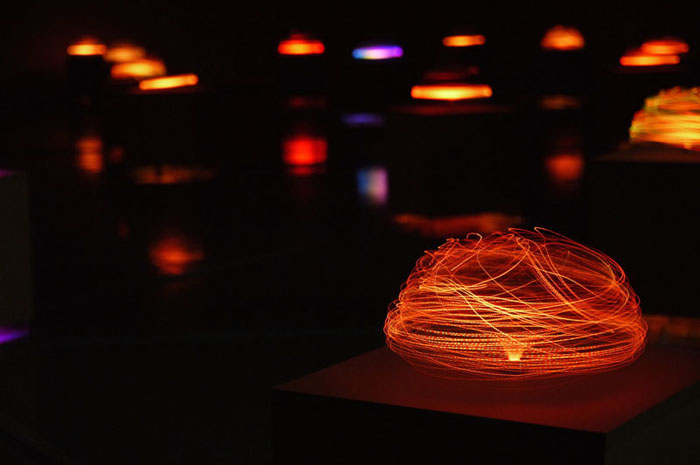Words by Meritxell Rosell
Dr Yoshimasa Kato is a Japanese artist, whose work spans from sound and media art to kinetic light sculpture. CLOT Magazine came across his work through an exciting collaboration project with Dr Yuichi Ito, for which they received an honourable mention in the interactive art category in Ars Electrónica, 2007. Neurobiology, cognition, sound vibration and sculpture blended and morphed into performance within close interaction with the audience.
For that project, White Lives on Speaker, brain wave patterns from a member of the audience were processed from an electroencephalograph live recording into software that transposed them into an audio frequency output that was played through a speaker which contained a potato starch solution.
Sound-translated brain waves created different shapes and forms as sort of mutating little sculptures, one could be tempted to say in sync with the observer’s state of mind. As the starch could also be touched and reshaped, the artists suggested it also could mean a way in which to physically interact with one’s own mind waves.
More recently, Kato’s interests have moved to kinetic light sculpture. Using fibre optics, LEDs and rotation the artist takes us into an interactive interface between media and reality where touch and hands are a central part of the interplay, reminiscent of the classic fine arts, like painting and sculpture or even more primitive forms like pottery.
The spectator can interact with and modify the piece of art becoming an integral part of it. For Kato, his work is a step forward in media art in which the interaction of the media itself with the audience is minimal.
Mirage Flower is a dazzling installation inspired by Japanese flower gardens. In this LED and fibre optic light garden, flowers change colour, size, shape and movement going through the four seasons in a time-frame of minute: They grow, they flower and they perish in an infinite programmed loop.
The audience can touch the sculpted flowers as if walking through a real garden and by that changing their shape and movements. This and other of Kato’s works become such a poetic evocation and reflection upon the perception of time, particularly prominent in Japanese culture, one in which we are not mere passers-by.
Your work involves or has involved sound, performance, kinetic art, light and new media technology. When and how did the fascination with them come about?
My grandfather is a carpenter who would create various objects at home when I was a child. I was able to witness many machines and tools being used, and I was excited to see how products were completed. I understood the joy of creating items, and so I enrolled in the university to learn about art and computers. As such, I was able to learn about new media art.
In particular, during my first electronic project in my third year at the university, I became fascinated by my ability to activate an LED light. Prior to this experience, I thought I would need to buy a moving or glowing device or that I would need tremendous knowledge to create this project.
Therefore, I was shocked when one LED light turned on. Since then, I have experimented with a variety of sensors and actuators, and have created installation works.
What are your aims as an artist working in between technology and art?
The relationship between technology and the arts is evolving. When a new technology is born, artists use it. Conversely, artists also give birth to new technologies. Technology is often sober and not flashy like a property man. However, the arts are reminiscent of what is amazing of it.
I believe that new media arts should hide and cover these technologies so that they cannot be felt. It is not about being surprised at the greatness of the technology, it is about being able to enjoy the scenes that the artworks generate.
My lighted artwork (Rokuro) does not use the latest technology that I created, but it was designed to create a new experience of wonder for the observer by combining a variety of techniques used to date.
In White Lives on Speaker, a project in which you collaborated with Dr Yuichi Ito, brainwaves were converted into sound and the sound waves translated into a sculptural manifestation. What were the biggest challenges you faced in its development?
In WLoS, the brainwaves are converted to sound and conveyed the sound to the speakers to create a form. Ito’s field is audio signal processing. He analyzed and generated the sound. I created an outer frame and loudspeakers to support the shape.
This work required pouring a high-viscosity liquid into the loudspeaker, so the speaker needed to be sufficiently reinforced and waterproofed. However, sometimes the speakers were still destroyed within two weeks.
In addition, the loudspeaker needed to hang in the air in order not to resonate. This work involved a viewer wearing an EEG, so we did not want the sound alone to affect the viewer’s brainwaves. However, it would remain exposed to the low-frequency sound of the body. After an hour of the experiment, they became tired of the sound.
What directions do you imagine taking your work in?
Currently, I often conduct workshops for children, and I discuss how it is fun to create things. If they can imagine creating things on their own, their worlds will change. Everyone has a computer, so it is possible to create different works.
In addition, they can also be presented on the Internet. It is not important to use new technology, but it is important to have a unique perspective. I hope to share it.
What is your chief enemy of creativity?
Knowledge. I have a habit of believing I cannot realize an idea if it is beyond my knowledge. Therefore, I attain a variety of interesting information on a daily basis and increase my abilities.
You couldn’t live without…
Curiosity about the wonders of the world. We have to continue to be sensitive to various things in order to create something new.








